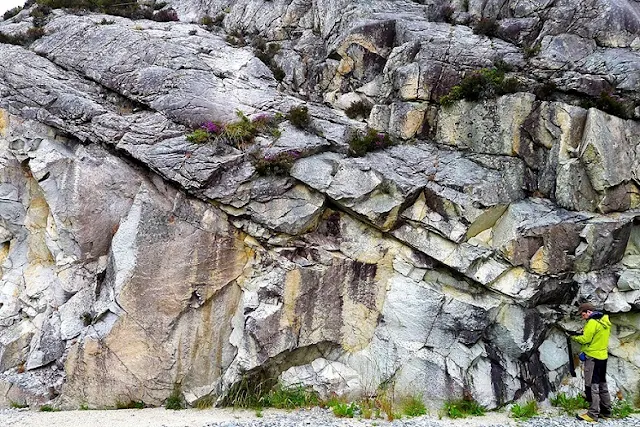New Study Describes 200 Million Years of Geological Evolution
 |
| Fault zone in Southern Norway shows 200 million years of reactivation history. |
200 million years of geological evolution of a fault in Earth's crust has recently been dated. Published in Nature Communications, these new findings may be used to shed light on poorly understood pathways for methane release from the heart of our planet.
Tectonic plates, big sections of Earth's crust and blocks underneath them, are constantly moving. The areas where these sections meet and interact are called faults. They appear as scars on the outermost layer of Earth. A lot is going on along the largest of faults: mountains can grow, volcanoes can erupt, continents can separate and earthquakes happen.
Also more discrete events are constantly happening close to faults: The emission of the greenhouse gas methane from ocean floor commonly occurs in gas hydrate provinces along tectonically active continental margins.
Active methane seepage happening frequently This is what makes brittle faults particularly alluring for CAGE/NGU researcher Jochen Knies. He is one of the coauthors of a new study in Nature Communications that, for the first time, precisely dates the evolution of a brittle fault from its initial formation to its later reactivation.
"Active methane leakage from the sea floor happens episodically, and frequently. Some seeps activate annually, others become active on a millennial scale. We need to better identify and characterize timing and duration of these leaks. It is critical for our understanding of the role the natural gas emissions play on global climate." says Jochen Knies, researcher at CAGE/NGU.
The story of the faults is the story of methane release Methane is a very potent greenhouse gas. The impacts of the industrial and agricultural release of the gas are well known and mapped. But the effects and quantities of the natural release of the gas, especially from the ocean floor, are poorly understood. Recent studies show that this natural release has been heavily underestimated.
The Nature Communications study focuses on brittle faults and fractures onshore in western Norway. Up to now, applications for directly fingerprinting the age of brittle faulting and reactivation -- and thus potentially the timing of gas emission through the crust -- did not exist.
"We have managed to precisely date several episodes of faulting and reactivation of brittle faults onshore Norway. Our study unravels and dates a complex evolution of the local brittle deformation, which straddles a 200 million year timespan." says Giulio Viola, the lead-author of the study .
The onshore study gives scientists the necessary tools to understand the age of offshore faults, which are important for methane release from gas hydrate provinces.
Improving the models and estimates of methane release The innovative method behind the study combines a twofold approach: the detailed structural analysis of faults, and the dating of their history by applying potassium/argon dating of the clay mineral illite. The faulting causes deformations in which illite can form, and just a few milligrams of the clay mineral are enough to do this type of dating.
"Testing this toolbox on fault and fracture systems below active sites of methane leakages, would potentially provide an innovative and unique possibility: By constraining the timing of offshore faulting episodes, we may ultimately be able to identify the events of increased methane emission to the ocean and atmosphere. These episodes are not something that is restricted to the past. They are happening now, and will be happening frequently in the future," concludes Knies.
The method and the findings may also improve current models that estimate the amounts of methane released from natural sources.
The above story is based on Materials provided by University of Tromso (Universitetet i Tromsø - UiT).

%20(1).webp)






